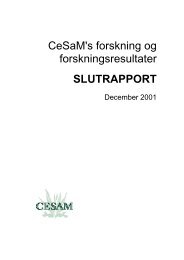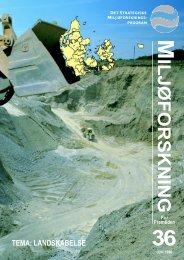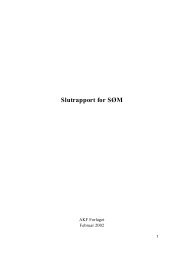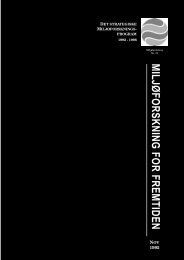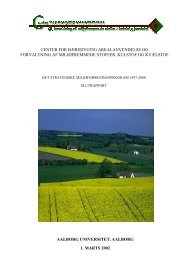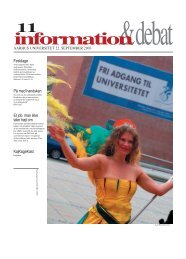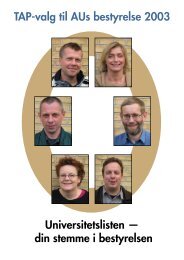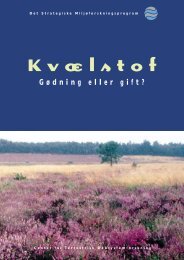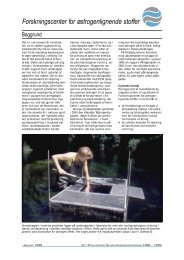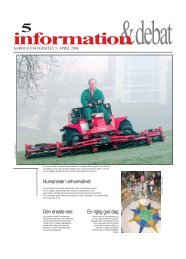I Strategiske og grundlagsskabende aktiviteter i øko - Info - Aarhus ...
I Strategiske og grundlagsskabende aktiviteter i øko - Info - Aarhus ...
I Strategiske og grundlagsskabende aktiviteter i øko - Info - Aarhus ...
Create successful ePaper yourself
Turn your PDF publications into a flip-book with our unique Google optimized e-Paper software.
Projekt II.1 Solbær <strong>og</strong> jordbær<br />
97<br />
20 jordbærsorter blev i projektperioden vurderet for deres egnethed til <strong>øko</strong>l<strong>og</strong>isk produktion. Af alle sorter<br />
viste ‘Honeoye’ sig at være mindst modtagelig over for gråskimmel, <strong>og</strong> den anses derfor for en velegnet<br />
tidlig sort til <strong>øko</strong>l<strong>og</strong>isk produktion. I hovedsæsonen gav ‘Kent’ <strong>og</strong> ‘Cortina’ gode udbytter, om end de er<br />
moderat modtagelige for gråskimmel. I sensæsonen var ‘Symphony’ <strong>og</strong> ‘Pandora’ relativt højtydende, selv<br />
om de begge er modtagelige for bladpletsygdomme.<br />
Totalt er der undersøgt 28 solbærsorter for deres egnethed til <strong>øko</strong>l<strong>og</strong>isk produktion. Af disse har det<br />
foreløbig vist sig at 'Titania' <strong>og</strong> 'Intercontinental' (BRi 831515-25) er de sundeste når det gælder<br />
svampesygdomme. 'Farleigh', som er resistent overfor knopgalmider, er desværre følsom for<br />
svampesygdomme <strong>og</strong> har givet lave udbytte.<br />
Der var signifikante forskelle mellem solbærsorter i indholdet af hydrocinnamiske syre derivater når<br />
planterne blev dyrker under <strong>øko</strong>l<strong>og</strong>iske forhold. Tidligt i vækstsæsonen var et højt niveau af caffeoyldiquinic<br />
syre <strong>og</strong> coumaroyl-quinic syre korreleret med sygdomsmodstandsdygtighed i solbær. Målinger af<br />
indholdet af hydroxycinnamic syre kunne være et vigtigt redskab for at hjælpe med at vælge sunde<br />
solbærsorter egnede til <strong>øko</strong>l<strong>og</strong>isk produktion.<br />
English summary<br />
Black currant plantings subsist for 10-12 years. During the project period the plants where produced,<br />
planted and 1999 was the first cropping year.<br />
During establishment all five cultivars and all four cover crops gave a sufficient nitr<strong>og</strong>en supply. The level<br />
of nitr<strong>og</strong>en in leaves and soil and the growth were smallest in the annual cover crop treatment consisting<br />
of vetch and rye. Powdery mildew infected ‘Ben Lomond’ very severe and caused a very little shoot<br />
growth. Consequently the yield was very little in 1999. The four other cultivars had a yield ranging from 2<br />
to 4 tons per ha. ‘Titania’ had the largest crop. There were no significant differences between the yield in<br />
different cover crops.<br />
Black currant production on legs to lighten the mechanical weed cleaning reduced the annual shoot<br />
growth. But this did not effect the yield the first cropping year.<br />
Infestations of aphids were smaller and leaf spot infection larger in the ‘Titania’ plants on legs. A stronger<br />
growth in the traditional bushes, but a more dense branch structure in plants on legs probably caused this.<br />
Mechanical weed cleaning was easier under plants on legs.<br />
If sulphur is used to control pest in the growing season the leaf scorching and leaf discolouring increases<br />
when the concentration of sulphur increases over 0-2-4-6-8 kg per ha. There were no significant<br />
differences in yield but a tendency towards a lower yield when the sulphur concentration increased this<br />
first cropping year. Sulphur treatments had a significant but not sufficient effect against mildew.<br />
Grey mould in strawberries was tried reduces using cultural methods. Post-harvest defoliation and finger<br />
harrowing was investigated in two cultivars. Post-harvest defoliation, though having some positive effect<br />
on marketable yield, did not reduce the incidence of Botrytis significantly. This was the case regardless of<br />
cut leaf material being removed from the plots or not. Finger harrowing, though in some instances having<br />
a negative effect on yield, did not control Botrytis significantly either. However, it was clearly demonstrated<br />
that, in organic strawberry growing, the incidence of Botrytis increases with plant age. Therefore, a shortterm<br />
cropping system may be more important in controlling Botrytis than both post-harvest defoliation and<br />
finger harrowing.<br />
In a trial 20 cultivars were evaluated for their suitability in organic production. Among all cultivars,<br />
‘Honeoye’ had the lowest susceptibility to Botrytis and is considered a good early ripening cultivar for<br />
organic production. During mid-season, ‘Kent’ and ‘Cortina’ yielded well, although they were moderately<br />
susceptible to Botrytis. In late season, ‘Symphony’ and ‘Pandora’ gave high yields, although they both<br />
appeared to be susceptible to leaf spot diseases.<br />
28 black currant cultivars were evaluated. So far ‘Titania’ and ‘Intercontinental’ (Bri 8315-25) were the<br />
cultivars less susceptible to diseases. ‘Farleigh’ is resistant to big bud mite but unfortunately it is<br />
susceptible to diseases and is not a high yielding cultivar.



